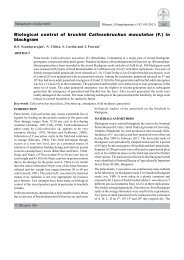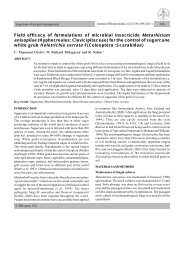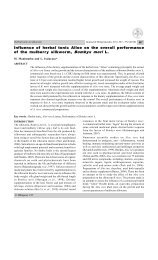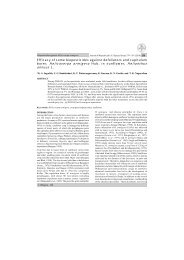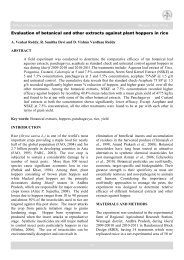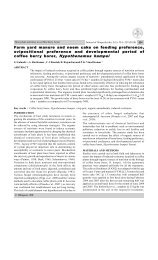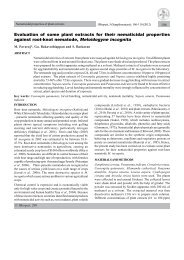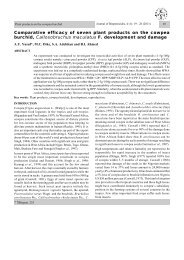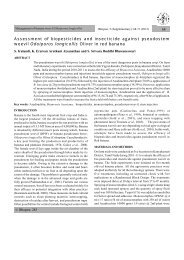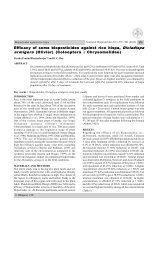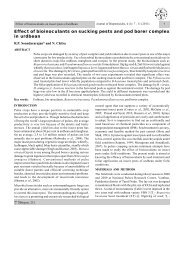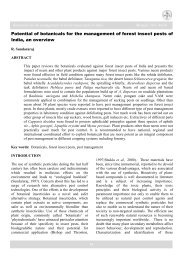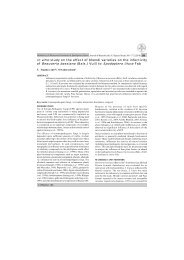Efficacy of larvicidal and pupicidal properties of ... - Jbiopest.com
Efficacy of larvicidal and pupicidal properties of ... - Jbiopest.com
Efficacy of larvicidal and pupicidal properties of ... - Jbiopest.com
You also want an ePaper? Increase the reach of your titles
YUMPU automatically turns print PDFs into web optimized ePapers that Google loves.
170<br />
Botanical <strong>and</strong> Fungal <strong>com</strong>bination for vector control<br />
JBiopest, 5 (supplementary): 170-176 (2012) 170<br />
<strong>Efficacy</strong> <strong>of</strong> <strong>larvicidal</strong> <strong>and</strong> <strong>pupicidal</strong> <strong>properties</strong> <strong>of</strong> Acalypha alnifolia<br />
Klein ex Willd. (Euphorbiaceae) leaf extract <strong>and</strong> Metarhizium anisopliae<br />
(Metsch.) against Culex quinquefasciatus Say. (Diptera: Culicidae)<br />
Kalimuthu Kovendan 1 *, Kadarkarai Murugan 1 , Savariar Vincent 2 <strong>and</strong> Donald R. Barnard 3<br />
ABSTRACT<br />
The present study was carried out to establish the <strong>properties</strong> <strong>of</strong> Acalypha alnifolia leaf extract <strong>and</strong> microbial<br />
insecticide, Metarizhium anisopliae on <strong>larvicidal</strong> <strong>and</strong> <strong>pupicidal</strong> activity against the lymphatic filarial vector,<br />
Culex quinquefasciatus. The methanol extract <strong>of</strong> A. alnifolia leaf showed <strong>larvicidal</strong> <strong>and</strong> <strong>pupicidal</strong> effects after<br />
24 h <strong>of</strong> exposure; with, the highest larval <strong>and</strong> pupal mortality was recorded against the first- to fourth-instar<br />
larvae <strong>and</strong> pupae <strong>of</strong> values LC 50<br />
= 5.67% 1 st instar, 6.62% 2 nd instar, 7.53% 3 rd instar <strong>and</strong> 9.05% 4 th instar, <strong>and</strong><br />
10.20% pupae respectively, <strong>and</strong> microbial insecticide, M. anisopliae against the first to fourth instar larvae <strong>and</strong><br />
pupae with LC 50<br />
values 1 st instar was 10.53%, 2 nd instar was 15.57%, 3 rd instar was 23.06%, <strong>and</strong> 4 th instar was<br />
31.36%, <strong>and</strong> pupae was 42.54%, respectively. Moreover, <strong>com</strong>bined treatment <strong>of</strong> values <strong>of</strong> LC 50<br />
values <strong>of</strong> 1 st instar<br />
was 3.73%, 2 nd instar was 4.72%, 3 rd instar was 5.55%, <strong>and</strong> 4 th instar was 7.66%, <strong>and</strong> pupae was 9.16%, respectively.<br />
No mortality was observed in the control. The results shows the leaves extract <strong>of</strong> A. alnifolia <strong>and</strong> the<br />
entomopathogenic fungi, M. anisopliae are c<strong>and</strong>idates for controlling lymphatic filarial vector, C.<br />
quinquefasciatus. Hence, A. alnifolia <strong>and</strong> M. anisopliae can be considered for eco-friendly vector control<br />
programs.<br />
Key words: Acalypha alnifolia, Metarizhium anisopliae, Culex quinquefasciatus, <strong>larvicidal</strong>, <strong>pupicidal</strong>, lymphatic filarial vector.<br />
INTRODUCTION<br />
Culex quinquefasciatus is one <strong>of</strong> the most annoying vectors<br />
which transmit lymphatic filariasis <strong>and</strong> Japanese encephalitis<br />
in India (Mourya et al., 1989; Das et al., 2002). P<strong>and</strong>ian et al.<br />
(1989) observed the repellent activity <strong>of</strong> herbal smoke on the<br />
biting activity <strong>of</strong> C. quinquefasciatus. Thangam <strong>and</strong><br />
Kathiresan (1992a) stated that smoke from burning various<br />
dry materials has been used since early times to deter insects<br />
especially mosquitoes. C. quinquefasciatus <strong>and</strong> many other<br />
Culex species bite their hosts at night. Cx. quinquefasciatus<br />
<strong>com</strong>monly rest indoors both before <strong>and</strong> after feeding, but<br />
also shelter in outdoor resting places (Service, 2000).<br />
Nirmal Sharma et al. (1998) reported <strong>larvicidal</strong> activity <strong>of</strong><br />
Gliricidia sepium crude ethanol extracts <strong>of</strong> dried leaves, fresh<br />
leaves, dried petioles <strong>and</strong> stem bark were tested for their<br />
activities against third instar larvae <strong>of</strong> Anopheles stephensi,<br />
Aedes aegypti <strong>and</strong> Culex quinquefasciatus. El Hag et al.<br />
(1999) observed the effect <strong>of</strong> methanolic extracts <strong>of</strong> neem<br />
seeds on egg hatchability <strong>and</strong> larval development <strong>of</strong> Cx.<br />
pipiens. The leaf extract <strong>of</strong> Acalypha indica with different<br />
solvents: benzene, chlor<strong>of</strong>orm, ethyl acetate, <strong>and</strong> methanol<br />
has ben tested for <strong>larvicidal</strong>, ovicidal activity, <strong>and</strong> oviposition<br />
© JBiopest. 302<br />
attractancy against An. stephensi (Govindarajan et al., 2008a).<br />
The leaf extract <strong>of</strong> Acalypha alnifolia with different solvents<br />
<strong>of</strong> tested for <strong>larvicidal</strong> activity against three important<br />
mosquitoes such as malarial vector, An. stephensi, dengue<br />
vector, A. aegypti <strong>and</strong> Bancr<strong>of</strong>tian filariasis vector, Cx.<br />
quinquefasciatus (Kovendan et al., 2012b).<br />
Acalypha alnifolia Klein ex Willd. (Family: Euphorbiaceae)<br />
known as Sirukurunjan in Tamil. Acalypha alnifolia is a shrub<br />
known as Cat-tail <strong>and</strong> Copperleaf found in the wild in South<br />
India (Garg, 2009).<br />
Entomopathogenic imperfect fungus like Metarhizium<br />
anisopliae show considerable promise for use in integrated<br />
pest management (IPM) programmes (Butt et al., 2001).<br />
Hyphomycetes fungal isolates <strong>of</strong> M. anisopliae <strong>and</strong> Beauveria<br />
bassiana is known to infect <strong>and</strong> kill adults <strong>of</strong> the African<br />
malaria vector Anopheles gambiae sensu stricto through tarsal<br />
contact in laboratory containers (Scholte et al., 2003; Blanford<br />
et al., 2005). M. anisopliae uses a <strong>com</strong>bination <strong>of</strong> enzymes<br />
<strong>and</strong> mechanical force to penetrate the host cuticle <strong>and</strong> access<br />
the nutrient-rich haemolymph (Wang et al., 2002). Conidia <strong>of</strong><br />
hyphomycetous fungi strongly adhere to insect cuticle, <strong>and</strong>
Kalimuthu Kovendan et al.<br />
the attachment <strong>of</strong> conidia to cuticles is through to involve<br />
non-specific adhesion mechanisms mediated by the<br />
hydrophobicity <strong>of</strong> the cell wall (Bouclas et al., 1988; 1991).<br />
Survival <strong>of</strong> entomopathogenic fungi requires a delicate<br />
balance <strong>of</strong> interaction between the fungus, host <strong>and</strong> the<br />
environment. In general, the life cycle <strong>of</strong> the<br />
entomopathogenic fungi involves an infective spore stage,<br />
which germinates on the cuticle <strong>of</strong> the host, forming a germ<br />
tube that penetrate the cuticle <strong>and</strong> invades the hemocoel <strong>of</strong><br />
the insect host (Hajek <strong>and</strong> Leger, 1994).<br />
Hence, in the present investigation an attempt has been made<br />
evaluate the A. alnifolia leaves <strong>and</strong> fungal pathogen, M.<br />
anisopliae on the <strong>larvicidal</strong>, <strong>pupicidal</strong> effect <strong>of</strong> on lymphatic<br />
filarial vector, Cx. quinquefasciatus.<br />
MATERIALS AND METHODS<br />
Collection <strong>and</strong> maintenance <strong>of</strong> insect<br />
The eggs <strong>of</strong> Cx. quinquefasciatus were collected from<br />
National Centre for Disease Control (NCDC) field station <strong>of</strong><br />
Mettupalayam, Tamil Nadu, India, using an “O”-type brush.<br />
These eggs were brought to the laboratory <strong>and</strong> transferred to<br />
18×13×4-cm enamel trays containing 500 ml <strong>of</strong> water for<br />
hatching. The mosquito larvae were fed with pedigree dog<br />
biscuits <strong>and</strong> yeast at 3:1 ratio. The feeding was continued<br />
until the larvae transformed into the pupal stage.<br />
The pupae were collected from the culture trays <strong>and</strong><br />
transferred to plastic containers (12×12 cm) containing 500 ml<br />
<strong>of</strong> water with the help <strong>of</strong> a dipper. The plastic jars were kept in<br />
a 90×90×90-cm mosquito cage for adult emergence. Mosquito<br />
larvae were maintained at 27°C±2°C, 75–85% relative humidity,<br />
under a photoperiod <strong>of</strong> 14:10 hrs light:dark. A 10% sugar<br />
solution was provided for a period <strong>of</strong> 3 days before blood<br />
feeding.<br />
The adult female mosquitoes were allowed to feed on the<br />
blood <strong>of</strong> a rabbit (a rabbit per day, exposed on the dorsal side)<br />
for 2 days to ensure adequate blood feeding for 5 days. After<br />
blood feeding, enamel trays with water from the culture trays<br />
were placed in the cage as oviposition substrates.<br />
Collection <strong>and</strong> preparation <strong>of</strong> plant extract<br />
A. alnifolia were collected from the Kallar Hills (Western<br />
Ghats), Mettupalyam, Coimbatore, India. The plants were<br />
identified at BSI (Botanical Survey <strong>of</strong> India), <strong>and</strong> the plants<br />
were deposited at Zoology Department, Bharathiar University,<br />
Coimbatore, Tamil Nadu, India. A. alnifolia plant was washed<br />
with tap water <strong>and</strong> shade-dried at room temperature. The<br />
dried plant materials (leaves). The powder (500 g) <strong>of</strong> the leaf<br />
was extracted with 1.5 litre <strong>of</strong> organic solvents <strong>of</strong> methanol<br />
using a Soxhlet apparatus at 60–80°C for 8 hrs (Vogel, 1978).<br />
The extract was concentrated under reduced pressure 22–26<br />
171<br />
mm Hg at 45°C <strong>and</strong> the residue obtained was stored at 4°C.<br />
The extracts were filtered through a Buchner funnel with<br />
Whatman No. 1 filter paper. The crude plant extracts were<br />
evaporated to dryness in rotary vacuum evaporator. One gram<br />
<strong>of</strong> the plant residue was dissolved in 100 mL <strong>of</strong> acetone (stock<br />
solution) <strong>and</strong> considered as 1% stock solution. From this<br />
stock solution, different concentrations were prepared ranging<br />
from 4 to 12%, respectively.<br />
Fungal preparation<br />
The <strong>com</strong>mercial fungal formulations <strong>of</strong> Metarhizium<br />
anisopliae (Metsch.) obtained from T- Stanes & Company<br />
Limited, Research Development Centre, Coimbatore, Tamil<br />
Nadu, India was used for the study. The required quantity <strong>of</strong><br />
entmopathogenic fungi, M. aniospliae liquid formulation was<br />
thoroughly mixed with distilled water to prepare at various<br />
conidia concentrations were adjusted 1x10 2 to 5x10 10 viable<br />
conidia/mL, respectively.<br />
Larval/pupal toxicity test<br />
Laboratory colonies <strong>of</strong> mosquito larvae/pupae were used for<br />
the <strong>larvicidal</strong>/<strong>pupicidal</strong> activity. Twenty-five numbers <strong>of</strong> 1 st to<br />
4 th instars larvae <strong>and</strong> pupae were introduced into 500 ml glass<br />
beaker containing 249 mL <strong>of</strong> dechlorinated water <strong>and</strong> 1 mL <strong>of</strong><br />
desired concentrations <strong>of</strong> plant extract, <strong>and</strong> fungi (liquid<br />
formulation) were added. Larval food was given for the test<br />
larvae. Each tested concentration, was thrice replicated. The<br />
control was set up by mixing 1 mL <strong>of</strong> acetone with 249 mL <strong>of</strong><br />
dechlorinated water. The larvae <strong>and</strong> pupae which were exposed<br />
to dechlorinated water without acetone served as control.<br />
The control mortalities were corrected by using Abbott’s<br />
formula (Abbott’s 1925). The LC 50<br />
<strong>and</strong> LC 90<br />
were calculated<br />
from toxicity data by using probit analysis (Finney, 1971).<br />
Statistical analysis<br />
All data were subjected to analysis <strong>of</strong> variance; the means<br />
were separated using Duncan’s Multiple Range Tests by Alder<br />
<strong>and</strong> Rossler (1977). SPSS (Statistical s<strong>of</strong>tware package) 9.0<br />
version was used. Results with P
Botanical <strong>and</strong> Fungal <strong>com</strong>bination for vector control.<br />
Forty percent mortality was noted in 1 st instar larvae treated<br />
with M. anisopliae at 1x10 2 conidia/mL, whereas it has been<br />
increased to 86% at 5x10 10 conidia/mL <strong>of</strong> M. anisopliae<br />
treatment, similarly 38% pupal mortality was noted in M.<br />
anisopliae treatment at 1x10 2 conidia/mL <strong>and</strong> it has been<br />
increased to 51% at 5x10 10 conidia/mL. Similar trend was also<br />
noted in all the instars <strong>of</strong> C. quinquefasciatus at different<br />
concentrations <strong>of</strong> M. anisopliae treatment (Table 2). The LC 50<br />
<strong>and</strong> LC 90<br />
values were dose <strong>and</strong> time dependent one..<br />
The concentration at 1.8% A. alnifolia + 1x10 10 M. anisopliae<br />
conidia/ml <strong>com</strong>bination for 1 st instar larvae mortality was<br />
recorded 96% (Table 3). The LC 50<br />
value <strong>of</strong> 1 st instar was 3.73%,<br />
2 nd instar was 4.72%, 3 rd instar was 5.55%, <strong>and</strong> 4 th instar was<br />
7.66%. The LC 90<br />
values were also dose <strong>and</strong> time dependent<br />
one.<br />
DISCUSSION<br />
Similarly, the methanolic extracts <strong>of</strong> Solanum suratence,<br />
Azadirachta indica <strong>and</strong> Hydrocotyl javanica exhibited<br />
<strong>larvicidal</strong> activity against Cx. quinquefasciatus<br />
(Venkatachalam <strong>and</strong> Jebanesan, 2001). The <strong>larvicidal</strong> activity<br />
<strong>of</strong> various plant extracts such as Pedalium murax, Cleome<br />
icosondra <strong>and</strong> Dictyosa dietotoma have been found to be<br />
promising against Cx. quinquefasciatus <strong>and</strong> An. stephensi<br />
172<br />
(Kalyanasundaram <strong>and</strong> Das, 1985) naturally occurring<br />
insecticides may play a more prominent role in mosquito<br />
control programs in the future (W<strong>and</strong>scheer et al., 2004).<br />
Vahitha et al. (2002) <strong>and</strong> Rajkumar <strong>and</strong> Jebanesan (2004)<br />
studied the <strong>larvicidal</strong> efficacy <strong>of</strong> plants against Cx.<br />
quinquefasciatus.<br />
A 23% mortality was noted at I instar larvae by the treatment<br />
<strong>of</strong> A. ilicifolius at 20 ppm, whereas it was increased to 89% at<br />
100 ppm <strong>of</strong> A. ilicifolius leaf extract treatment (Kovendan <strong>and</strong><br />
Murugan, 2011). Kovendan et al. (2011a, b) recently have<br />
reported that the leaf extract <strong>of</strong> methanol Jatropha curcas<br />
against Cx. quinquefasciatus <strong>and</strong> Leucas aspera leaf extract<br />
against An. stephensi, respectively. The results <strong>of</strong> the leaf<br />
extract <strong>of</strong> A. alnifloia are promising as good <strong>larvicidal</strong> activity<br />
against the mosquito vector, An. stephensi, Ae. aegypti, Cx.<br />
quinquefasciatus (Kovendan et al. 2012 b). A very recent<br />
study by Murugan et al. (2012) reported that the <strong>com</strong>bination<br />
<strong>of</strong> A. alnifolia <strong>and</strong> M. anisopliae against the malarial vector,<br />
An. stephensi as target species.<br />
Scholte et al. (2005) reduced the longevity <strong>of</strong> adult female An.<br />
gambiae mosquitoes to 3.49 days from 9.30 days by applying<br />
the spores <strong>of</strong> M. anisopliae, which is similar to the present<br />
study. Blanford et al. (2005) for the first time used the<br />
impregnated spores <strong>of</strong> M. anisopliae for interrupting the<br />
Table 1. Larval <strong>and</strong> pupal toxicity effect <strong>of</strong> A. alnifolia methanol leaf extract against lymphatic filarial vector, C. quinquefasciatus<br />
Mosquito<br />
larval<br />
instars <strong>and</strong><br />
pupae<br />
% <strong>of</strong> larval <strong>and</strong> pupal mortality<br />
Concentration <strong>of</strong> A. alnifolia (%)<br />
4 6 8 10 12<br />
LC 50 (LC 90 )<br />
95% confidence limit<br />
LFL<br />
UFL<br />
LC 50 (LC 90 ) LC 50 (LC 90 )<br />
x 2<br />
(df = 4)<br />
1 st Instar<br />
2 nd Instar<br />
3 rd Instar<br />
4 th Instar<br />
41 a<br />
38 ab<br />
34 b<br />
29 c 53 a<br />
46 b<br />
41 c<br />
36 d 62 a<br />
55 b<br />
51 b<br />
43 c 73 a<br />
67 b<br />
64 b<br />
55 c 91 a<br />
78 b<br />
71 b<br />
64 c 5.67<br />
(13.03)<br />
6.62<br />
(16.18)<br />
7.53<br />
(17.69)<br />
9.05<br />
(20.13)<br />
4.68<br />
(11.78)<br />
5.51<br />
(14.10)<br />
6.53<br />
(15.20)<br />
8.07<br />
(16.90)<br />
6.41<br />
(15.01)<br />
7.47<br />
(19.98)<br />
8.43<br />
(22.41)<br />
10.29<br />
(26.68)<br />
3.77*<br />
0.51*<br />
0.35*<br />
0.27*<br />
Pupa 18 d 31 e 38 d 53 c 56 d 10.20<br />
(19.81)<br />
9.29<br />
(16.97)<br />
11.54<br />
(25.11) 1.77*<br />
Control-Nil mortality, LFL = Lower Fiducidal Limit, UFL = Upper Fiducidal Limit, x 2 –Chi-square value, df - degrees <strong>of</strong> freedom,<br />
Within a column means followed by the same letter(s) are not significantly different at 5% level by DMRT. *Significant at P < 0.05<br />
level.
Kalimuthu Kovendan et al.<br />
173<br />
Table 2. Larval <strong>and</strong> pupal toxicity effect <strong>of</strong> microbial insecticide, M. anisopliae against lymphatic filarial vector, C. quinquefasciatus<br />
Mosquito<br />
larval instars<br />
<strong>and</strong> pupae<br />
% <strong>of</strong> larval <strong>and</strong> pupal mortality<br />
95% confidence limit<br />
Concentration <strong>of</strong> M. anisopliae<br />
(conidia/ml/liter) LFL UFL<br />
1x10 2 2x10 4 3x10 6 4x10 8 5x10 10 LC 50 (LC 90 )<br />
LC 50 (LC 90 ) LC 50 (LC 90 )<br />
x 2<br />
(df = 4)<br />
1 st Instar<br />
2 nd Instar<br />
3 rd Instar<br />
4 th Instar<br />
38 a<br />
35 ab<br />
31 bc<br />
27 cd 51 a<br />
47 ab<br />
43 b<br />
35 c 58 a<br />
53 ab<br />
47 c<br />
46 bc 71 a<br />
65 b<br />
58 c<br />
53 c 86 a<br />
74 b<br />
67 c<br />
59 d 10.53<br />
(57.70)<br />
15.57<br />
(78.54)<br />
23.06<br />
(94.17)<br />
31.36<br />
(108.18)<br />
4.72<br />
(48.89)<br />
8.69<br />
(63.55)<br />
16.56<br />
(74.16)<br />
24.59<br />
(83.43)<br />
14.97<br />
(72.18)<br />
21.10<br />
(107.40)<br />
29.92<br />
(136.22)<br />
41.34<br />
(163.74)<br />
0.94*<br />
1.48*<br />
1.59*<br />
2.49*<br />
Pupa 22 d 31 c 39 d 47 d 51 e 42.54<br />
(125.94)<br />
33.83<br />
(94.56)<br />
59.93<br />
(202.94) 2.77*<br />
Control-Nil mortality, LFL = Lower Fiducidal Limit, UFL = Upper Fiducidal Limit, x 2 –Chi-square value, df - degrees <strong>of</strong> freedom, Within a<br />
column means followed by the same letter(s) are not significantly different at 5% level by DMRT. *Significant at P < 0.05 level.<br />
Table 3. Combined treatment <strong>of</strong> larval <strong>and</strong> pupal toxicity effect <strong>of</strong> A. alnifolia <strong>of</strong> methanol leaf extract <strong>and</strong> microbial insecticide,<br />
M. anisopliae against lymphatic filarial vector, C. quinquefasciatus<br />
LC 50 (LC 90 )<br />
1x10 2 1x10 4 1x10 6 1x10 8<br />
% <strong>of</strong> larval <strong>and</strong> pupal mortality<br />
Mosquito<br />
95% confidence limit<br />
larval Concentration <strong>of</strong> A. alnifolia (%) +<br />
1x10 10<br />
instars <strong>and</strong> M. anisopliae (conidia/ml/liter) LFL UFL<br />
pupae 1.0 1.2 1.4 1.6 1.8<br />
+ + + + +<br />
LC 50 (LC 90 ) LC 50 (LC 90 )<br />
1 st Instar 47 a 61 a 71 a 82 a 96 a 3.73<br />
2.54<br />
4.57<br />
4 th Instar 28 c 39 c 48 d 61 d 68 d 7.66<br />
6.71<br />
8.67<br />
(10.90) (9.86) (12.47)<br />
2 nd Instar 42 b 50 b 65 b 76 b 84 b 4.72<br />
3.44<br />
5.63<br />
(13.83) (12.19) (16.56)<br />
3 rd Instar 39 b 48 b 56 c 70 c 79 c 5.55<br />
4.29<br />
6.49<br />
(15.87) (13.71) (19.76)<br />
(18.26) (15.60) (23.15)<br />
x 2<br />
(df = 4)<br />
3.41*<br />
0.41*<br />
0.55*<br />
0.25*<br />
Pupa 20 d 30 d 45 d 54 e 60 e 9.16<br />
(19.26)<br />
8.25<br />
(16.49)<br />
10.38<br />
(24.26) 1.35*<br />
Control-Nil mortality, LFL = Lower Fiducidal Limit, UFL = Upper Fiducidal Limit, x 2 –Chi-square value, df - degrees <strong>of</strong> freedom, Within a<br />
column means followed by the same letter(s) are not significantly different at 5% level by DMRT. *Significant at P < 0.05 level.
Botanical <strong>and</strong> Fungal <strong>com</strong>bination for vector control.<br />
malaria transmission in Tanzania <strong>and</strong> reduced the transmission<br />
by a factor <strong>of</strong> 80. The fungal cells developing within the<br />
insects may possess an outer coat, which is neutral to<br />
circulating heamocytes or they are effectively masked by host<br />
proteins or by producing immuno-modulating substances<br />
which suppress the cellular defence mechanism, the fungal<br />
cells may be tolerant to the humoral <strong>and</strong> cellular defence<br />
system <strong>of</strong> the insects. The M. anisopliae showed to be<br />
pathogenicity <strong>of</strong> larvae <strong>of</strong> Cx. quinquefasciatus, <strong>of</strong> the<br />
mosquito larvae when exposed to 1 x 10 6 dry conidia. For the<br />
successful conidial attachment <strong>and</strong> in the end, killing <strong>of</strong> a<br />
mosquito, a threshold number <strong>of</strong> conidia per unit surface area<br />
are required. In our lethal dose response experiment the lowest<br />
dose resulting in a significant effect on mosquito survival<br />
was 1 x 10 8 conidia/ml. The results <strong>of</strong> this study show that<br />
laboratory condition is more significant to the field (Scholte<br />
et al. 2003).<br />
Kamalakannan et al. (2008) proved that the entomopathogenic<br />
fungus, M. anisopliae is being considered as a biocontrol<br />
agent for the adult mosquito <strong>of</strong> A. stephensi. In our results,<br />
96% <strong>and</strong> 94% adult mortality was observed in oil <strong>and</strong> water<br />
formulated conidia <strong>of</strong> M. anisopliae. Similarly, adult<br />
emergency rate also decreased with increasing concentration<br />
(1x10 8 conidia/ml). Finally, we conclude that the fungal spores<br />
or cells developed within insect cuticle which suppresses the<br />
cellular defence system <strong>and</strong> also fungal growth on the legs<br />
<strong>and</strong> wings to arrest the mosquito movement. Recently,<br />
Kamalakannan <strong>and</strong> Murugan (2011) investigations were<br />
undertaken on 10 microbial product to develop a strategy to<br />
control mosquito larval <strong>and</strong> pupal population in the laboratory<br />
<strong>and</strong> field. Highest larval mortality was evident in the lab with<br />
LC 50<br />
<strong>and</strong> LC 90<br />
at 0.25 <strong>and</strong> 0.5 at 24 h for Ae. aegypti as observed<br />
for the the larvae <strong>of</strong> C. quinquefasciatus were more<br />
susceptible than the larvae <strong>of</strong> A. stephensi <strong>and</strong> A. aegypti<br />
(Mohanty et al., 2008).<br />
In conclusion, the evaluation <strong>of</strong> <strong>larvicidal</strong>, <strong>pupicidal</strong> activity<br />
<strong>of</strong> M. anisopliae <strong>and</strong> A. alnifolia against the vector Culex<br />
quinquefasciatus depicted as a good biocontrol agent<br />
Entomopathogenic fungi are considered excellent c<strong>and</strong>idates<br />
for bio-pesticides due to their safety, relatively limited host<br />
range, ease <strong>of</strong> production <strong>and</strong> suitability <strong>of</strong> large scale<br />
production.<br />
ACKNOWLEDGMENTS<br />
The authors are thankful to the Department <strong>of</strong> Science <strong>and</strong><br />
Technology (DST), Govt. <strong>of</strong> India, New Delhi, India <strong>and</strong> Tamil<br />
Nadu State Council for Science <strong>and</strong> Technology (TNSCST),<br />
Chennai, Tamil Nadu for providing financial support for the<br />
present work. The authors are grateful to Mr. N.<br />
Muthukrishnan, Technician <strong>and</strong> Mr. A. Anbarasan, Lab<br />
174<br />
Assistant, National Centre for Diseases Control (NCDC),<br />
Mettupalayam, Tamil Nadu for helping in mosquito sample<br />
collection <strong>and</strong> in the identification <strong>of</strong> mosquito species <strong>of</strong><br />
samples provided for the experiment work.<br />
REFERENCES<br />
Abbott, W. S. 1925. A method <strong>of</strong> <strong>com</strong>puting the effectiveness<br />
<strong>of</strong> an insecticide. Journal <strong>of</strong> Economic Entomology, 18:<br />
265–266.<br />
Alder, H. L. <strong>and</strong> Rossler, E. B. 1977. Introduction to probability<br />
<strong>and</strong> statistics. Freeman, San Francisco, 246 P.<br />
Blanford, S., Chan, B. H. K., Jenkins, N., Sim, D., Turner, R. J.,<br />
Read, A. F. <strong>and</strong> Thomas, M. B. 2005. Fungal pathogen<br />
reduces potential for malaria transmission. Science,<br />
308:1638–1641.<br />
Bouclas, D. G., Pendl<strong>and</strong>, J. C. <strong>and</strong> Latge, J. P. 1991. Attachment<br />
<strong>of</strong> mycopathogens to cuticle: The initial event <strong>of</strong> mycoses<br />
in arthropod hosts. In: The Fungal Spore <strong>and</strong> Disease<br />
Intiation in Plants <strong>and</strong> Animals (Cole, G. T. <strong>and</strong> Hoch, H.<br />
C. eds.), Plenum, New York, 101-128 PP.<br />
Bouclas, D. G., Pendl<strong>and</strong>, J. C. <strong>and</strong> Latge, J. P. 1988. Nonspecific<br />
factors involved in attachment <strong>of</strong> entomopathogenic<br />
Deuteromyctes to host insect cuticle. Applied<br />
Environmental Microbiology, 54: 1795-1805.<br />
Butt, T. M., Jackson, C. W. <strong>and</strong> Magan, N. 2001. Fungi as<br />
biocontrol agents: potential progress <strong>and</strong> problems. CAB<br />
International, Wallingford.<br />
Das, P. K., Pani, S. P. <strong>and</strong> Krishnamoorthy, K. 2002. Prospects<br />
<strong>of</strong> elimination <strong>of</strong> lymphatic filariasis in India. ICMR<br />
Bulletin, 32: 41–54.<br />
El Hag, E. A., Nadi, A. H. <strong>and</strong> Zaitoon, A. A. 1999. Toxic <strong>and</strong><br />
growth retarding effects <strong>of</strong> three plant extracts on Culex<br />
pipiens larvae (Diptera: Culicidae). Phytotherapy<br />
Research, 13: 388-392.<br />
Finney, D. J. 1971. Probit Analysis. Cambridge University,<br />
London. 68–78 PP.<br />
Garg, J. M. 2009. Information |Description={{en|1=Acalypha<br />
capitata’ Willd. (=Acalypha alnifolia Klein ex Willd.) in<br />
Keesara, Rangareddy district, Andhra Pradesh, India.<br />
Govindarajan, M., Jebanesan, A., Pushpanathan, T. <strong>and</strong><br />
Samidurai, K. 2008a. Studies on effect <strong>of</strong> Acalypha indica<br />
L. (Euphorbiaceae) leaf extracts on the malarial vector,<br />
Anopheles stephensi Liston (Diptera:Culicidae).<br />
Parasitology Research, 103(3): 691-695.<br />
Hajek, A. E <strong>and</strong> Leger, R. J. 1994. Interactions between fungal<br />
pathogens <strong>and</strong> insect host. Annual Review <strong>of</strong><br />
Entomology, 39: 293-322.<br />
Kalyanasundaram, M. <strong>and</strong> Das, P. K. 1985. Larvicidal <strong>and</strong><br />
synergistic activity <strong>of</strong> plant extracts for mosquito control.<br />
Indian Journal <strong>of</strong> Medical Research, 82: 19-23.<br />
Kamalakannan, S., Murugan, K., Naresh Kumar, A.,<br />
Ramasubramanian, N. <strong>and</strong> Mathiyazhagan, P. 2008<br />
Adulticidal effect <strong>of</strong> fungal pathogen, Metarhizium
Kalimuthu Kovendan et al.<br />
anisopliae on malarial vector Anopheles stephensi<br />
(Diptera: Culicidae). African Jouranl <strong>of</strong><br />
Biotechnology, 7(6): 838-841.<br />
Kamalakannan, S. <strong>and</strong> Murugan, K. 2011. Laboratory<br />
<strong>and</strong> field evaluation <strong>of</strong> Metarhizium anisopliae for<br />
the control <strong>of</strong> dengue vector, Aedes aegypti (Insecta:<br />
Diptera: Culicidae) Toxicology & Environmental<br />
Chemistry, 1-8 PP (in press).<br />
Kovendan, K. <strong>and</strong> Murugan, K. 2011. Effect <strong>of</strong><br />
Medicinal Plants on the Mosquito Vectors from the<br />
Different Agro-climatic Regions <strong>of</strong> Tamil Nadu, India.<br />
Advances in Environmental Biology, 5(2): 335-<br />
344.<br />
Kovendan, K., Murugan, K., Vincent, S. <strong>and</strong><br />
Kamalakannan, S. 2011a. Larvicidal efficacy <strong>of</strong><br />
Jatropha curcas <strong>and</strong> bacterial insecticide, Bacillus<br />
thuringiensis, against lymphatic filarial vector, Culex<br />
quinquefasciatus Say. (Diptera: Culicidae).<br />
Parasitology Research, DOI 10.1007/s00436-011-<br />
2368-6.<br />
Kovendan, K., Murugan, K., Vincent, S. <strong>and</strong> Donald R.<br />
Barnard. 2012a. Studies on <strong>larvicidal</strong> <strong>and</strong> <strong>pupicidal</strong><br />
activity <strong>of</strong> Leucas aspera Willd. (Lamiaceae) <strong>and</strong><br />
bacterial insecticide, Bacillus sphaericus, against<br />
malarial vector, Anopheles stephensi Liston.<br />
(Diptera: Culicidae) Parasitology Research, 110:<br />
195–203.<br />
Kovendan, K., Murugan, K. <strong>and</strong> Vincent, S. 2012b.<br />
Evaluation <strong>of</strong> <strong>larvicidal</strong> activity <strong>of</strong> Acalypha alnifolia<br />
Klein ex Willd. (Euphorbiaceae) leaf extract against<br />
the malarial vector, Anopheles stephensi, dengue<br />
vector, Aedes aegypti <strong>and</strong> Bancr<strong>of</strong>tian filariasis<br />
vector, Culex quinquefasciatus (Diptera: Culicidae)<br />
Parasitology Research, 110:571– 581.<br />
Mourya, D. T, Iikal, M. A., Mishra, A. C., Jacob, P. G.,<br />
Pant, U., Ramanujam, S., Mavale, M. S., Bhat, H.<br />
R. <strong>and</strong> Dh<strong>and</strong>a, V. 1989. Isolation <strong>of</strong> Japanese<br />
encephalitis virus from mosquitoes collected in<br />
Karnataka state, India from 1985 to 1987.<br />
Transactions <strong>of</strong> The Royal Society <strong>of</strong> Tropical<br />
Medicine <strong>and</strong> Hygiene, 83: 550–552.<br />
Mohanty, S., Raghavendra, K. <strong>and</strong> Dash, A. P. 2008.<br />
Induction <strong>of</strong> chymoelastase (Pr1) <strong>of</strong> Metarhizium<br />
anisopliae <strong>and</strong> its role in causing mortality to mosquito<br />
larvae. World Journal <strong>of</strong> Microbiology <strong>and</strong><br />
Biotechnology, 24: 2283–2288.<br />
Murugan, K., Kovendan, K., Vincent, S. <strong>and</strong> Barnard,<br />
D. R. 2012. Bio<strong>larvicidal</strong> <strong>and</strong> <strong>pupicidal</strong> activity <strong>of</strong><br />
175<br />
Acalypha alnifolia Klein ex Willd. (Family:<br />
Euphorbiaceae) leaf extract <strong>and</strong> Microbial insecticide,<br />
Metarhizium anisopliae (Metsch.) against malaria<br />
fever mosquito, Anopheles stephensi Liston.<br />
(Diptera: Culicidae). Parasitology Research, DOI<br />
10.1007/s00436-011-2758-9.<br />
Nirmal Sharma, J. S., Qadry, B., Subramanium, T.,<br />
Verghese, S. J., Rahman, S. K., Sharma, S. <strong>and</strong><br />
Jalees, S. 1998. Larvicidal activity <strong>of</strong> Gliricidia<br />
sepium against mosquito larvae <strong>of</strong> Anopheles<br />
stephansi, Aedes aegypti <strong>and</strong> Culex<br />
quinquefasciatus. Pharmaceutical Biology, 36: 3–<br />
7.<br />
P<strong>and</strong>ian, R. S., Dwarkanath, S. K. <strong>and</strong> Martin, P. 1989.<br />
Repellent activity <strong>of</strong> herbal smoke on the biting activity<br />
<strong>of</strong> mosquitoes. Journal <strong>of</strong> Ecobiology, 1: 287–289.<br />
Rajkumar, S. <strong>and</strong> Jebanesan, A. 2004. Mosquitocidal<br />
activities <strong>of</strong> octasane from Moschosma<br />
polystachyum Linn. (Lamiaceae). Journal <strong>of</strong><br />
Ethnopharmacology, 90: 87–89.<br />
Scholte, E. J., Takken, W. <strong>and</strong> Knols, B. G. J. 2003.<br />
Pathogenicity <strong>of</strong> six east African entomopathogenic<br />
fungi to adult Anopheles gambiae S.S. (Diptera:<br />
Culicidae) mosquitoes. Proceedings <strong>of</strong><br />
Experimental Applied Entomology NEV,<br />
Amsterdam, 14: 25-29.<br />
Scholte, E. J., Njiru, B. N., Smallegange, R. C., Takken,<br />
W. <strong>and</strong> Knols, B. G. J. 2005. Infection <strong>of</strong> adult malaria<br />
(Anopheles gambiae s.s.) <strong>and</strong> filariasis (Culex<br />
quinquefasciatus) vectors with the<br />
entomopathogenic fungus Metarhizium anisopliae.<br />
Malaria Jounral, 2: 29.<br />
Thangam, T. S. <strong>and</strong> Kathiresn, K. (1992a). Mosquito<br />
<strong>larvicidal</strong> activity <strong>of</strong> mangrove plant extracts against<br />
Aedes aegypti. International Pest Control, 34<br />
(166): 119.<br />
Service, M. W. 2000. Medical entomology for students,<br />
2nd edn. Cambridge University Press, Cambridge,<br />
52–55 P.<br />
Vahitha, R., Venkatachalam, M. R., Murugan, K. <strong>and</strong><br />
Jebanesan A. 2002. Larvicidal efficacy <strong>of</strong> Pavonia<br />
zeylanica L. <strong>and</strong> Acacia ferruginea D. C. against Culex<br />
quinquefasciatus Say. Bioresource Technology, 82: 203–<br />
204.<br />
Venkatachalam, M. R. <strong>and</strong> Jebanesan, A. 2001. Larvicidal<br />
activity <strong>of</strong> Hydrocotyl javanica Thumb.(Apiaceae)<br />
extract against Culex quinquefasciatus. Journal <strong>of</strong><br />
Experimental Zoology India, 4(1): 99–101.<br />
Vogel, A. I. 1978. Text book <strong>of</strong> practical organic chemistry.<br />
Society <strong>and</strong> Longman, London, 1369 P.
176<br />
W<strong>and</strong>scheer, C. B., Duque, J. E., da Silva, M. A. N., Fukuyama,<br />
Y., Wohlke, J. L, Adelmann, J. <strong>and</strong> Fontana, J. D. 2004.<br />
Larvicidal action <strong>of</strong> ethanolic extracts from fruit endocarps<br />
<strong>of</strong> Melia azedarach <strong>and</strong> Azadirachta indica against the<br />
dengue mosquito Aedes aegypti. Toxicon, 44: 829–835.<br />
Wang, C., Typas, M. A. <strong>and</strong> Butt, T. M. 2002. Detection <strong>and</strong><br />
characterization <strong>of</strong> Pr1 virulent gene deficiencies in the<br />
insect pathogenic fungus Metarhizium anisopliae. FEMS<br />
Microbiology Letter, 213: 251–255.<br />
Kalimuthu Kovendan 1 *, Kadarkarai Murugan 1 <strong>and</strong><br />
Savariar Vincent 2<br />
1-Division <strong>of</strong> Entomology, Department <strong>of</strong> Zoology, School<br />
<strong>of</strong> Life Sciences, Bharathiar University, Coimbatore –<br />
641 046,Tamil Nadu, India.<br />
2-P.G. Research <strong>and</strong> Department <strong>of</strong> Advanced Zoology<br />
<strong>and</strong> Biotechnology, Loyola College, Nungambakkam,<br />
Chennai – 600 034, Tamil Nadu, India.<br />
3-Centre for Medical, Agriultural <strong>and</strong> Veterinary<br />
Entomology, USDA-ARS, Gainesville, FL 32608, USA.<br />
*Phone: +91- 9962447932 E-mail:<br />
gokulloyo@yahoo.co.in<br />
Received: October 17, 2011 Revised: January 31, 2012 Accepted: February 3, 2012



